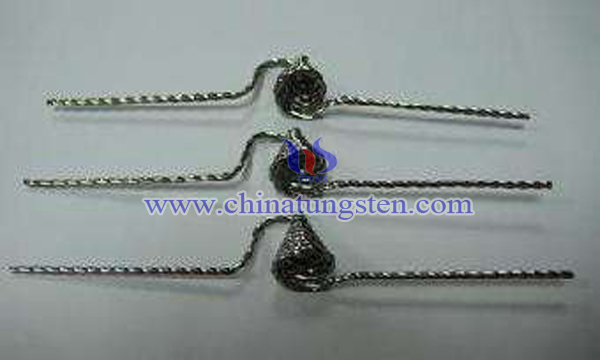Tungsten-Lanthanum Alloy Wire
- Details
- Category: Tungsten Information
- Published on Friday, 03 August 2018 18:23
The current tungsten filaments in bulbs are tungsten alloy wires made of ammonium paratungstate (APT) as main material with potassium, aluminum and silicon. This tungsten alloy wire thus has the disadvantages of low cold resistance, low thermal resistance, and poor photoelectric performance. In the process of tungsten wire manufacture, the rotary forging and drawing process will harden the tungsten alloy, and increases internal stress, thus it is easy to break when pulling; this increases the difficulty of production. The hardening of the alloy and the presence of internal stresses result in a shorter service life of the tungsten wire and poorer impact resistance, and the filament is prone to sagging after use.

In order to overcome the deficiencies of the current technique, the lanthanum can be added to enhance its performance by changing the alloy composition and the grain size thereof.
The preparation processes of the tungsten-lanthanum alloy wire include:
1) Pre-reducing ammonium paratungstate to tungsten blue in a high purity hydrogen in a reduction furnace;
2) Wet-mixing potassium silicate and aluminum nitrate solution, mixing and drying, stirring, so that potassium, silicon and aluminum are adsorbed in the gap of tungsten blue;
3) Use a pressure spray gun to spray the ammonium citrate solution to the tungsten blue mixed solution in the doping pot while stirring, and then it is dried, to obtain a mixture of ammonium citrate and tungsten blue ;
4) Place the mixture solution into a reduction furnace, and perform a reduction reaction in high purity hydrogen to obtain a crude powder of reduced tungsten-ruthenium alloy;
5) The reduced tungsten-rhenium alloy powder is washed with quantitative hydrochloric acid and hydrofluoric acid to remove excess dopant and other impurities to obtain a pure tungsten-rhenium alloy powder;
6) Apply an equal force to the tungsten-rhenium alloy powder contained in the elastic mold sleeve by using an isostatic press to form a tungsten billet with uniform density;
7) The tungsten billet is pre-sintered under the shielding of hydrogen to obtain a pre-sintered billet;
8) The pre-sintered billet is subjected to self-resistance sintering under the shielding of hydrogen to obtain a sintered billet;
9) Use a swaging device to forge the sintered billet, the cross-section of the sintered billet is gradually reduced, the length is increased, and the tungsten structure, grain state and surface state of the billet are changed to obtain a tungsten rod;
10) Anneal the tungsten rod;
11) The annealed tungsten rod is further swaged to obtain a tungsten rod with a diameter of 3.7 mm;
12) The tungsten rod is roughly stretched on the large turntable, and the tungsten rod passes through the die hole on the turntable, and the section is reduced and the length is increased to obtain a thick tungsten wire;
13) The thick tungsten wire is oxidized and annealed in the air by a flame, and is coated with graphite and a single compression of a small compression ratio to eliminate processing hardening and reduce the tensile strength of the tungsten wire;
14) The thick tungsten wire is drawn into a desired fine tungsten wire through a plurality of modes.
The tungsten-lanthanum alloy wire is changed by the addition of a small amount of lanthanum element, thereby changing the composition of the tungsten wire and its internal grain size, and at the same time eliminating the stress in the tungsten-lanthanum alloy wire by oxidation annealing, thus producing Tungsten wire has good impact resistance. 10 bulbs (14V 0.1A 0.7CP) using tungsten-lanthanum alloy wire produced by this method has a average wire size of 1.0mg/200mm and 1.2mg/200mm, under the same conditions as ordinary tungsten wire. The shock resistance test results of both are compared. With the same specification of 1.2mg/200mm, the average number of times of impact of ordinary tungsten wire is 673 times, and the average number of times of resistance of tungsten-lanthanum alloy wire is 1233 times. With the specification of 1.0mg/200mm, the bulb has a normal impact resistance of 680 times for ordinary tungsten wire, while the tungsten-lanthanum alloy wire is 1209 times.
- Tungsten Alloy Manufacturer & Supplier, Chinatungsten Online: www.tungsten-alloy.com
- Tungsten News & Prices of China Tungsten Industry Association: www.ctia.com.cn
- Molybdenum News & Price: news.molybdenum.com.cn
- Tel.: 86 592 5129696; Fax: 86 592 5129797; Email: sales@chinatungsten.com



 sales@chinatungsten.com
sales@chinatungsten.com